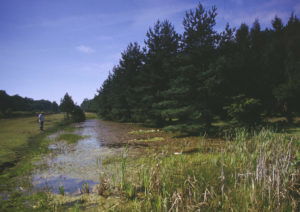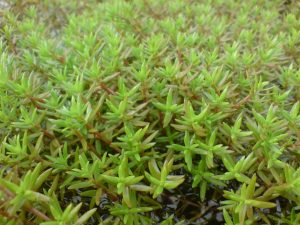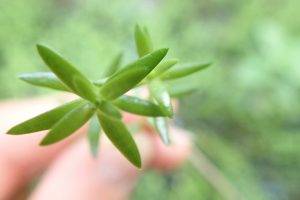Check, Clean, Dry: preventing the spread of invasive species in the New Forest
11th August 2022
Freshwater Habitats Trust is encouraging people to adopt the simple three-step Check, Clean, Dry approach to prevent the spread of invasive species in the New Forest.
The New Forest is world famous for its wetland wildlife. From source to sea, the ponds and bogs, rivers and streams, mudflats and saltmarshes are all extremely special for plants and animals alike.
The grazing livestock and a landscape which boasts areas of clean unpolluted wetland habitats, make the New Forest one of the best and most Important Freshwater Landscapes and coastal areas in the UK.
The New Forest is the second smallest National Park, yet it has the highest proportion of designated land for nature conservation in England. This makes it an attractive location to live, work and play.
However, as it’s one of the most visited National Parks in England, people can sometimes have a negative impact on the plants and wildlife that have been here for thousands of years. As an ancient landscape with a deep natural history, it’s important to ensure our time in the Forest and along the coast goes without harm and keeps nature in balance. One such impact is the spread of invasive non-native species.
 A New Forest pond (c) A Welstead
A New Forest pond (c) A Welstead
The spread of invasive species in the New Forest
Across the UK, we’ve seen an increase in the spread of non-native species introduced into the wild, usually by accident. The New Forest is no exception. The high movement of people means that some invasive non-native plants and animals have taken hold. When these species become dominant, this has a detrimental impact on the landscape and the native wildlife that lives here, disrupting the fragile balance of nature.
Our freshwater and coastal environments are particularly susceptible to invasive non-native species. This is because it doesn’t take long for seeds and animals to disperse and colonise through flowing water.
Once an invasive species takes over, the impacts include:
- the loss of native plants and wildlife including fish and birds in some wetland habitats
- reduced water quality
- increased risk of flooding.
 Crassula helmsii
Crassula helmsii  Crassula helmsii
Crassula helmsii
How you can help reduce the spread
Next time you visit the Forest, plan ahead to reduce the risk of spreading invasive species.
Invasive species can survive on damp clothing and kit for up to 14 days. It only takes one seed, egg or animal to take hold and become established in an ecosystem.
Organisations across the New Forest National Park are working in Partnership to raise awareness and actively eradicate invasive non-native species. It’s a big challenge, but in recent years Hampshire and Isle of Wight Wildlife Trust and others have been removing some of the worst offending invasive species, including Himalayan balsam and Japanese knotweed. Others, such as New Zealand pigmy weed and water primrose, are more difficult to tackle.
Check, Clean, Dry
Check, Clean, Dry is a national campaign led by the GB Non-native Species Secretariat (NNSS).
Whatever activities you’re planning in the New Forest, adopting the Check, Clean, Dry approach will help to reduce the risk of accidentally introducing any invasive species Always check that a recreational activity is permitted before you arrive. Cycling, camping, fishing and access to water are only allowed in designated places.
Many invasive species can cling onto bike tyres, kayaks and other paddle sports vessels, fishing equipment, children’s pond dipping nets, footwear and clothing including buoyancy aids and even tents and camping equipment.
Check
- After finishing your activity check your equipment, clothes and footwear for mud, animals (even small), and plant material.
- Remove anything you find and leave it at the site.
- Make sure you check nooks and hard to reach places on fishing kit, paddle vessels, camping gear and footwear.
- Don’t forget to check the dog as they too can carry invasive species from the last place they visited.
Clean
- Once away from the natural environment, clean everything thoroughly as a soon as you can.
- Some equipment can be cleaned using hot water. This is a quick and effective method to clean equipment and kit. It is recommended you submerge for about 15 minutes at around 45 degrees. This will kill most aquatic invasive non-native species.
- For everything else, clean using water and a damp cloth or a boot brush. Don’t forget the hard to reach places in boats, nets, buoyancy aids, bike tyres and footwear.
Dry
- Drain equipment, such as paddle sport boats.
- It’s vital to dry equipment, footwear and clothing for as long as possible before using elsewhere.
Some extra tips to stop the spread
Your vehicle could spread invasive species. Please keep to established and permitted roads, tracks and parking areas to minimise the risk. Parking on verges in the National Park is prohibited for this and many other reasons.
Follow the Be Plant Wise approach. Think about which plants you are putting into your garden and try to stop non-native plants spreading into the wild.
Our message is:
- come prepared
- check where to go
- make sure you have clean footwear and kit
- keep to the car parks and tracks
- leave nothing behand and only take away a love of the Forest.
In partnership with the New Forest National Park Authority and funded by the Green Recovery Challenge Fund and Environment Agency, Our project, Wilder for Water, works with visitors, organisations and businesses to raise awareness of the special qualities of the New Forest waterscape. Together, we’re promoting a best practice ‘clean water standard’ for camping and recreation across the National Park and beyond.
